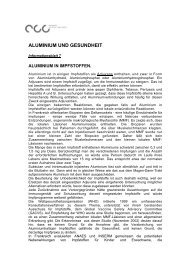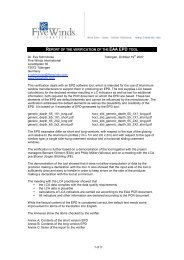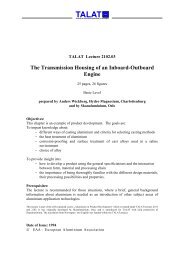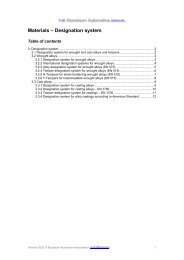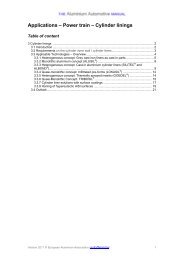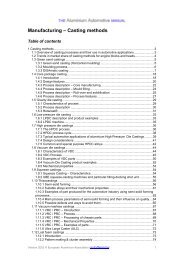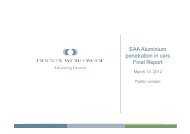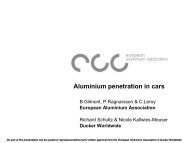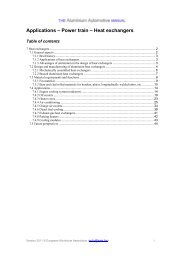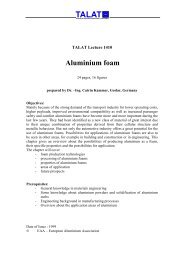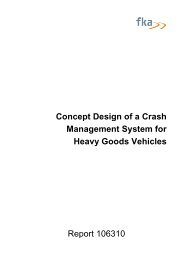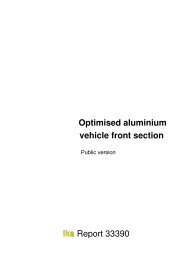aluminium in commercial vehicles - European Aluminium Association
aluminium in commercial vehicles - European Aluminium Association
aluminium in commercial vehicles - European Aluminium Association
Create successful ePaper yourself
Turn your PDF publications into a flip-book with our unique Google optimized e-Paper software.
68 EUROPEAN ALUMINIUM ASSOCIATION ALUMINIUM IN COMMERCIAL VEHICLES CHAPTER VI<br />
Situations Ref. EN 1999-1-1 Resistance<br />
Members 6.3.3<br />
Members subject to bend<strong>in</strong>g and axial compression may fail <strong>in</strong> one of<br />
<strong>in</strong> bend<strong>in</strong>g<br />
the two ways listed below:<br />
and axial<br />
• flexural buckl<strong>in</strong>g<br />
compression<br />
• lateral-torsional buckl<strong>in</strong>g<br />
6.3.3.1<br />
Comb<strong>in</strong>ation formulas are given for members with axial<br />
compression <strong>in</strong> comb<strong>in</strong>ation with bend<strong>in</strong>g about one or two axis<br />
and fail for flexural buckl<strong>in</strong>g. These formulas are given for:<br />
• open double symmetric cross-section<br />
• solid cross-section<br />
• hollow cross-section and tube<br />
• open mono-symmetrical cross-section<br />
6.3.3.2<br />
Comb<strong>in</strong>ation formula for open cross-section symmetrical about<br />
major axis, centrally symmetric or double symmetric cross-section<br />
is given for lateral- torsional buckl<strong>in</strong>g.<br />
Formulas are also given for calculation of the follow<strong>in</strong>g effects:<br />
6.3.3.3<br />
• members conta<strong>in</strong><strong>in</strong>g localized welds<br />
6.3.3.4<br />
• members conta<strong>in</strong><strong>in</strong>g localized reduction of cross-section<br />
6.3.3.5<br />
• unequal end moments and/or transverse loads<br />
Plate girders 6.7<br />
A plate girder is a deep beam with a tension flange, a compression<br />
flange and a web plate. The web is usually slender and may be<br />
re<strong>in</strong>forced by transverse or/and longitud<strong>in</strong>al stiffeners.<br />
Webs buckle <strong>in</strong> shear at relatively low applied loads, but considerably amount<br />
of post-buckled strength can be mobilized due to tension field action.<br />
Plate girders are sometimes designed with transverse web re<strong>in</strong>forcement<br />
<strong>in</strong> form of corrugations or closely-spaced transverse stiffeners (extrusions).<br />
Plate girders can be subjected to comb<strong>in</strong>ations of moment, shear<br />
and axial load<strong>in</strong>g, and to local load<strong>in</strong>g on the flanges. Because<br />
of their slender proportions they may be subjected to lateral<br />
torsional buckl<strong>in</strong>g, unless properly supported along the length.<br />
Failure (buckl<strong>in</strong>g) modes may be:<br />
6.7.2 & 6.7.3 • web buckl<strong>in</strong>g by compressive stresses<br />
6.7.4 & 6.8 • shear buckl<strong>in</strong>g<br />
6.7.6<br />
• <strong>in</strong>teraction between shear force and bend<strong>in</strong>g moment<br />
6.7.5<br />
• buckl<strong>in</strong>g of web because of local loads on flanges<br />
6.7.7<br />
• flange-<strong>in</strong>duced web buckl<strong>in</strong>g<br />
6.1.5<br />
• torsional buckl<strong>in</strong>g of flange (local buckl<strong>in</strong>g)<br />
6.3.2<br />
• lateral torsional buckl<strong>in</strong>g



